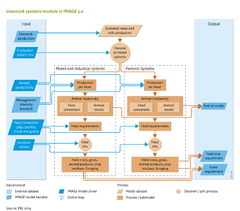Livestock systems/Description: Difference between revisions
Jump to navigation
Jump to search
No edit summary |
No edit summary |
||
| Line 3: | Line 3: | ||
|Reference=Seré and Steinfeld, 1996; | |Reference=Seré and Steinfeld, 1996; | ||
|Description=For each world region, IMAGE distinguishes two livestock production systems, namely pastoral systems and mixed/industrial systems, on the basis of [[FAO]] studies ([[Seré and Steinfeld, 1996]]). In general, pastoral systems are dominated by extensive ruminant production systems. Mixed and industrial systems are more intensive than pastoral ones, and animal husbandry comprises grazing ruminants and monogastrics. For years up to the present, the distribution of livestock production over the two systems, for each IMAGE region, is constructed from historical data, whereas for future years, this depends on the scenario selected. | |Description=For each world region, IMAGE distinguishes two livestock production systems, namely pastoral systems and mixed/industrial systems, on the basis of [[FAO]] studies ([[Seré and Steinfeld, 1996]]). In general, pastoral systems are dominated by extensive ruminant production systems. Mixed and industrial systems are more intensive than pastoral ones, and animal husbandry comprises grazing ruminants and monogastrics. For years up to the present, the distribution of livestock production over the two systems, for each IMAGE region, is constructed from historical data, whereas for future years, this depends on the scenario selected. | ||
IMAGE distinguishes five animal categories: beef and dairy cattle (large ruminants), goats and sheep as one group (small ruminants) and pigs and poultry (monogastrics). The numbers of animals and their shares per production system are calculated from data on domestic livestock production, per region, provided by the agricultural economy model ([[Agricultural economy and forestry]]) ( | IMAGE distinguishes five animal categories: beef and dairy cattle (large ruminants), goats and sheep as one group (small ruminants) and pigs and poultry (monogastrics). The numbers of animals and their shares per production system are calculated from data on domestic livestock production, per region, provided by the agricultural economy model ([[Agricultural economy and forestry]]) (see figure on the right). The number of animals per category is calculated from the total production per region and per animal specific to that region. Stocks of dairy cows ([[HasAcronym::POP]]), per country or world region, are obtained from total milk production ([[HasAcronym::PROD]]) and the milk production per animal ([[HasAcronym::MPH]]): | ||
Animal stocks per region, for the categories beef cattle, pigs, and sheep and goats, is obtained from production and carcass weight ([[HasAcronym::CW]]) and off-take rate ([[HasAcronym::OR]]): | Animal stocks per region, for the categories beef cattle, pigs, and sheep and goats, is obtained from production and carcass weight ([[HasAcronym::CW]]) and off-take rate ([[HasAcronym::OR]]): | ||
| Line 10: | Line 10: | ||
The next step involves the calculation of energy requirements. Energy requirements of dairy cattle are calculated for the energy needed for maintenance (based on body weight), feeding (based on the fraction of grass in feed rations), lactation (based on milk production per cow) and pregnancy (based on the number of calves per year). The amount of dry matter feed is calculated based on the fraction of digestible energy in total energy and the energy content of biomass. | The next step involves the calculation of energy requirements. Energy requirements of dairy cattle are calculated for the energy needed for maintenance (based on body weight), feeding (based on the fraction of grass in feed rations), lactation (based on milk production per cow) and pregnancy (based on the number of calves per year). The amount of dry matter feed is calculated based on the fraction of digestible energy in total energy and the energy content of biomass. | ||
For cattle, feed requirements are based on animal activity and production, whereas for pigs, poultry, sheep and goats, feed requirements are based on Feed Conversion Ratios ([[HasAcronym::FCR]]). FCR is the amount of feed (kg dry matter) required to produce one kilogram of milk or meat. For FCR values, historical data are provided up to the present; for future years, FCR values depend on the scenario selected. | For cattle, feed requirements are based on animal activity and production, whereas for pigs, poultry, sheep and goats, feed requirements are based on Feed Conversion Ratios ([[HasAcronym::FCR]]). FCR is the amount of feed (kg dry matter) required to produce one kilogram of milk or meat. For FCR values, historical data are provided up to the present; for future years, FCR values depend on the scenario selected. | ||
For the calculation of the required areas of cropland and grassland ([[ | For the calculation of the required areas of cropland and grassland ([[Agricultural systems]]) are calculated on the basis of feed crop and grass requirements. These in turn are calculated from total feed requirement and diet composition (feed rations). IMAGE distinguishes five feed categories: | ||
# grass, including hay and grass silage; | # grass, including hay and grass silage; | ||
#food crops and by-products from processing ; | #food crops and by-products from processing ; | ||
Revision as of 10:56, 16 December 2013
Parts of Livestock systems/Description
| Component is implemented in: |
| Components: |
| Related IMAGE components |
| Projects/Applications |
|
| Models/Databases |
| Key publications |
| References |
